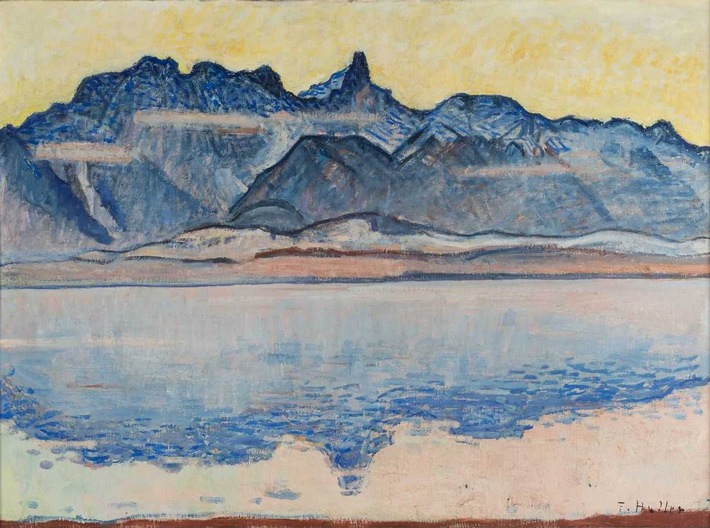News:
Masterpiece to Stay in St. Gallen: An Agreement is Reached on Ferdinand Hodler’s “Thunersee mit Stockhornkette”

Ferdinand Hodler’s famous painting “Thunersee mit Stockhornkette” (Lake Thun with Stockhorn Chain) (around 1913) will remain on public display at Kunstmuseum St. Gallen thanks to a long-anticipated agreement with the Simon und Charlotte Frick Foundation. Frick, the former State Councillor of St. Gallen, and his wife acquired the painting at auction at Galerie Kornfeld in Bern in 1985. At the time, the auction catalog erroneously documented a flawless Swiss provenance. Later, contrary to these claims, it was revealed that a previous owner of the painting had been the German Jewish collector Max Silberberg who, along with his wife Johanna, was murdered by the Nazis in 1942. The work had been sold from Silberberg’s collection in Berlin in 1935.
Despite uncertainty surrounding the circumstances of the painting’s sale in 1935 and the identity of its interim owners, following years of negotiations, the Frick family, particularly the children of the benefactors, Elisabeth Frick Tanner and Eugen Frick, have successfully reached a conclusive agreement. In addition, seven other historically significant artworks from the Simon und Charlotte Frick Foundation will become permanent loans to Kunstmuseum St. Gallen, enriching the collection significantly.
Research conducted by the Swiss Institute for Art Research (SIK-ISEA) revealed that the provenance attributed to “Thunersee mit Stockhornkette” in 1985 was incorrect, most likely due to misidentification. In fact, the Kornfeld provenance belonged to a different version of Stockhornkette, another of the thirty-three known versions that Hodler made between 1905 and 1913. The St. Gallen version was painted around 1913, and documented as part of the collection of Breslau industrialist Silberberg no later than 1930.
Silberberg had amassed significant works by French Impressionist and German artists, from the 19th and 20th centuries, and his collection gained widespread recognition throughout Europe. He sold a number of paintings for business reasons in the early 1930s, but from 1935, under pressure from the Nazi regime, he was forced to part with more significant portions of his collection through multiple sales at Paul Graupe auction house in Berlin. Silberberg and his wife were increasingly disenfranchised, and had their assets confiscated, before they were both murdered in Theresienstadt concentration camp. Their son, Alfred, and his wife, Gerta, managed to escape to England in 1939.
It remains unclear the extent to which the sale of the painting during the Nazi era was due to persecution, business circumstances, or a combination of the two, and the name of the purchaser and where the proceeds of the sale went also remain unconfirmed. However, from 1946 onwards, the painting is documented as having been in the possession of Bern-based physician Dr. Bernhard Walthard.
Whether Hodler’s landscape should have been considered looted art under the Washington Agreement of 1998 remains controversial. Internationally, the responsibilities of public museums concerning artworks confiscated, or forcibly sold, by the Nazis are regulated by guidelines set out by the 1998 Washington Conference. As with any other museum in Switzerland, Kunstmuseum St. Gallen is committed to these guidelines and has played a crucial role mediating between the Frick Foundation and the Silberberg estate to resolve this claim.
Kunstmuseum St. Gallen will continue to fulfill its role as a visual archive and a place of remembrance: conducting research, and documenting and presenting the history of exhibited artworks to the public. Even works with problematic pasts will be displayed with their origins disclosed transparently. This serves to acknowledge past injustices, as in the case of Silberberg, and to keep the stories of such collectors and their fate alive in the public mind. At the same time, Hodler’s “Thunersee mit Stockhornkette” highlights the significant collecting efforts of the Frick family and their philanthropic commitment to enriching the public collection at Kunstmuseum St. Gallen.
Kunstmuseum St. Gallen would like to express its gratitude to the Simon und Charlotte Frick Foundation, and especially to Elisabeth Frick Tanner and Eugen Frick for their patience and efforts in resolving this complex case, as well as for their generous preservation of this important painting for the museum and its visitors.
Press Contact
Gianni Jetzer
Museumstrasse 32
9000 St. Gallen
T +41 71 242 06 84
direktion@kunstmuseumsg.ch
kunstmuseumsg.ch


